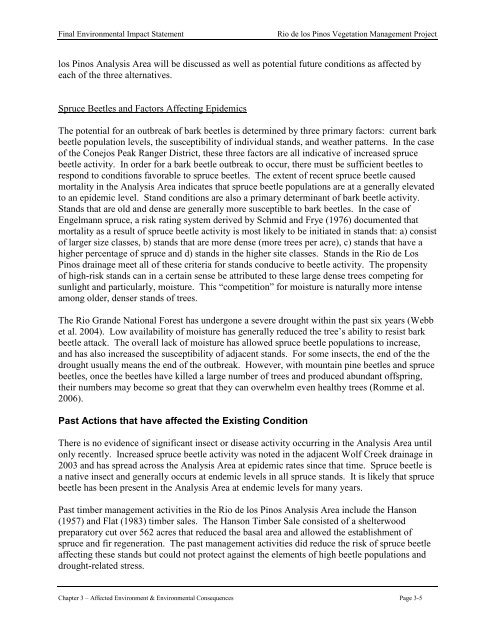Final Environmental Impact Statement Rio de los Pinos Vegetation ...
Final Environmental Impact Statement Rio de los Pinos Vegetation ...
Final Environmental Impact Statement Rio de los Pinos Vegetation ...
Create successful ePaper yourself
Turn your PDF publications into a flip-book with our unique Google optimized e-Paper software.
<strong>Final</strong> <strong>Environmental</strong> <strong>Impact</strong> <strong>Statement</strong> <strong>Rio</strong> <strong>de</strong> <strong>los</strong> <strong>Pinos</strong> <strong>Vegetation</strong> Management Project<br />
<strong>los</strong> <strong>Pinos</strong> Analysis Area will be discussed as well as potential future conditions as affected by<br />
each of the three alternatives.<br />
Spruce Beetles and Factors Affecting Epi<strong>de</strong>mics<br />
The potential for an outbreak of bark beetles is <strong>de</strong>termined by three primary factors: current bark<br />
beetle population levels, the susceptibility of individual stands, and weather patterns. In the case<br />
of the Conejos Peak Ranger District, these three factors are all indicative of increased spruce<br />
beetle activity. In or<strong>de</strong>r for a bark beetle outbreak to occur, there must be sufficient beetles to<br />
respond to conditions favorable to spruce beetles. The extent of recent spruce beetle caused<br />
mortality in the Analysis Area indicates that spruce beetle populations are at a generally elevated<br />
to an epi<strong>de</strong>mic level. Stand conditions are also a primary <strong>de</strong>terminant of bark beetle activity.<br />
Stands that are old and <strong>de</strong>nse are generally more susceptible to bark beetles. In the case of<br />
Engelmann spruce, a risk rating system <strong>de</strong>rived by Schmid and Frye (1976) documented that<br />
mortality as a result of spruce beetle activity is most likely to be initiated in stands that: a) consist<br />
of larger size classes, b) stands that are more <strong>de</strong>nse (more trees per acre), c) stands that have a<br />
higher percentage of spruce and d) stands in the higher site classes. Stands in the <strong>Rio</strong> <strong>de</strong> Los<br />
<strong>Pinos</strong> drainage meet all of these criteria for stands conducive to beetle activity. The propensity<br />
of high-risk stands can in a certain sense be attributed to these large <strong>de</strong>nse trees competing for<br />
sunlight and particularly, moisture. This “competition” for moisture is naturally more intense<br />
among ol<strong>de</strong>r, <strong>de</strong>nser stands of trees.<br />
The <strong>Rio</strong> Gran<strong>de</strong> National Forest has un<strong>de</strong>rgone a severe drought within the past six years (Webb<br />
et al. 2004). Low availability of moisture has generally reduced the tree’s ability to resist bark<br />
beetle attack. The overall lack of moisture has allowed spruce beetle populations to increase,<br />
and has also increased the susceptibility of adjacent stands. For some insects, the end of the the<br />
drought usually means the end of the outbreak. However, with mountain pine beetles and spruce<br />
beetles, once the beetles have killed a large number of trees and produced abundant offspring,<br />
their numbers may become so great that they can overwhelm even healthy trees (Romme et al.<br />
2006).<br />
Past Actions that have affected the Existing Condition<br />
There is no evi<strong>de</strong>nce of significant insect or disease activity occurring in the Analysis Area until<br />
only recently. Increased spruce beetle activity was noted in the adjacent Wolf Creek drainage in<br />
2003 and has spread across the Analysis Area at epi<strong>de</strong>mic rates since that time. Spruce beetle is<br />
a native insect and generally occurs at en<strong>de</strong>mic levels in all spruce stands. It is likely that spruce<br />
beetle has been present in the Analysis Area at en<strong>de</strong>mic levels for many years.<br />
Past timber management activities in the <strong>Rio</strong> <strong>de</strong> <strong>los</strong> <strong>Pinos</strong> Analysis Area inclu<strong>de</strong> the Hanson<br />
(1957) and Flat (1983) timber sales. The Hanson Timber Sale consisted of a shelterwood<br />
preparatory cut over 562 acres that reduced the basal area and allowed the establishment of<br />
spruce and fir regeneration. The past management activities did reduce the risk of spruce beetle<br />
affecting these stands but could not protect against the elements of high beetle populations and<br />
drought-related stress.<br />
Chapter 3 – Affected Environment & <strong>Environmental</strong> Consequences Page 3-5
















